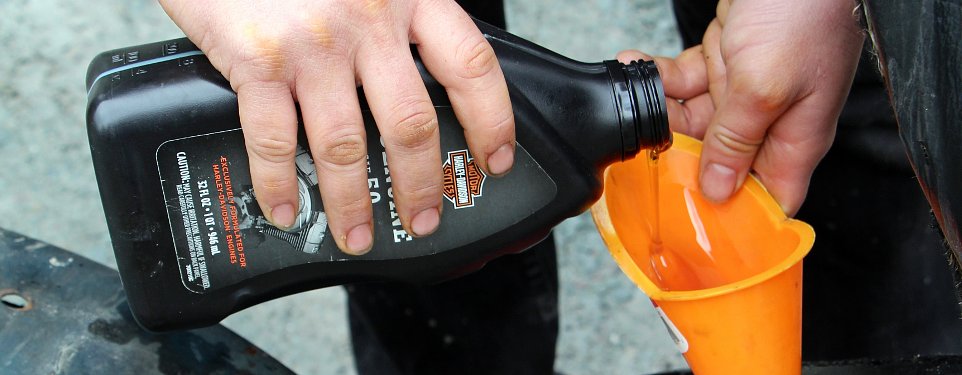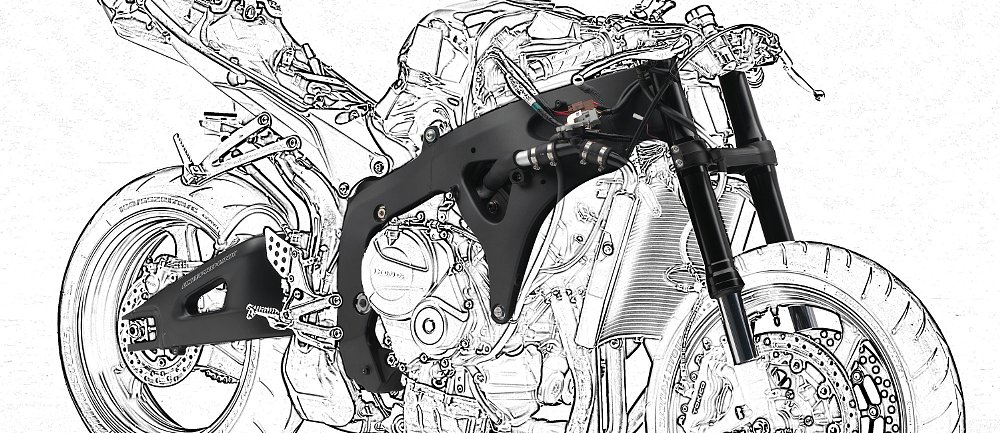“What oil should I put in my bike?”
Asking this in some circles is like asking about religion, politics, and someone’s mother and wife (followed by a lecherous wink) all at the same time. Now, before I enter the fray, let me list my qualifications or lack thereof. I am not a metallurgist, nor a chemist. I do not build engines full-time. My opinion and a buck fifty will get you a cup of coffee down at the diner. What I do have is some experience tearing down engines and rebuilding them, plenty of time to read, a few brain cells to rub together, and a soapbox to stand on to talk about oil.
I also got some friends and contacts. To fill in some of my knowledge gaps, I contacted a dear friend, Andrew Toback. Andy is a chemical engineer who works in the emissions control and catalyst services industry, and he’s also an avid motorcyclist and a pretty handy wrench. Jon Barber, Senior Product Manager for Harley-Davidson’s Oil, Maintenance & Tools Division, also jumped in to help riders know what to look for in an oil and what to look out for.
Rather than try to cover every dang thing about every lubricant ever, I am going to address the questions about oil I am asked most frequently, in normal layman’s terms. (Andy, however, may venture off into some jargon, but that’s why we brought him in; his knowledge of big words.) Please note that this piece really only applies to four-stroke machines; smokers have their own special, different lubricant needs.
I have an oil change coming up. What oil should I use?
Whatever your bike’s owner’s manual calls for. It’s difficult to go wrong with what the factory recommends. The bike’s engineers know what your bike needs, and they are also smart enough to diligently research all manner of petroleum products. As long as the API, ILSAC, or JASO classification is the same from one brand to another and the oil’s viscosity is correct, you’re set to fly. (Those alphabet-soup groups are petroleum organizations that set standards for lubricating fluids. Your manual will specify some set of criteria, likely from one of these bodies, but possibly from another.)
But I want to use XXX type of oil. Is that a good idea?
Maybe. But if you’re asking that, you really have to ask yourself two questions. First, do you understand lubricants well enough to make that decision? I don’t mean you have to be a petroleum engineer. I’m simply saying that if you can understand specifications, properties, and have a firm grasp of the operating conditions inside your engine, you should be more comfortable deviating than if you have little experience with the myriad of lubricants and additives on the market.

Another item of consideration is what you need the lubricant to deliver. Factory recommendations may be fine, but irregular or non-standard use may signify a need to deviate from that specification. A bike that is started three times a year, is run very gently and may receive infrequent oil changes can probably use an oil that’s very different than a racebike that is run at max rpm almost from startup and is torn down twice a season.
Do I need a detergent oil?
Most oil you will find for sale readily now is a detergent oil, but that was not always the case. In the early days of engines, oil was not recirculated. It moved through the engine and onto the ground. At some point, someone got the bright idea to capture that oil and reuse it. Well, that oil started to get pretty dirty, so after that, filtration systems began showing up on motorcycles. Early engines, designed without a filtration system in mind, had valleys and baffles designed to “catch” the accumulation of oil and dirt, known as sludge, that built up to keep it from harming the engine. The debris sank to the bottom of the oil and was deposited in those areas.
To filter oil, though, the debris needs to be picked up and moved to the oil filter, so detergents are added to the oil to keep the dirt in suspension.
“Detergents surround dirt particles and keep them entrained in the oil. This helps them get to the filter (instead of settling to a surface) so they can be collected and removed from the oil,” Andy said.
Long story short: If your bike uses a filter (and unless you ride a real antique, it does), you probably need a detergent oil.
Should I use synthetic or conventional oil or synthetic blend?
Synthetic oil can rarely hurt things, but that doesn’t mean everyone needs to use it.
Way back when, people mistakenly thought synth oil could actually be too slippery, leading to “bearing skate.” This myth has been disproven many times by now. At this juncture, there are two main drawbacks to using synthetic oil. The first is that because the molecules of synth oil are smaller, they are more easily able to pass through cracks, seals, and gaskets. What that may mean is that a leak may form that wasn’t occurring with conventional oil. The synthetic oil doesn’t cause the leak, it simply finds an existing path to exit that may not have been previously identified as a leak. It doesn't cause leaks, rather, it finds them.
The second drawback is the cost. Synth oil is pretty expensive compared to conventional or synthetic blends. If you change oil based on time, not mileage, it might not be the stuff for you. Alternatively, if you are laying down huge amounts of miles, you may blow through oil so quickly that the cost could be outrageous.

But, as you’ve likely discovered, synthetics have some benefits that you can’t always get with conventional oils. Synthetic oils often have premium additive packages, which means they often help an engine resist wear, oxidation, and stay better lubricated than engines run on conventional oils that may use lesser-quality additives. The area where synthetics really outperform conventional oils is in the temperature department. They are able to resist damage that occurs from heat at higher temps than conventional oil can withstand. All oil molecules can break down into shorter lengths and eventually become a deposit, like varnish, but synthetics can often go the distance where a conventional oil might break down. This can be a consideration with air-cooled machines specifically because they see much wider temperature fluctuations than their liquid-cooled counterparts.
Synthetic blend is just what it sounds like: a mixture of synth and conventional oils. The blend is not simply a 50/50 mix, and because some components of the additive packages for synthetic and conventional oils are incompatible, the individual additives differ. It's important to remember that the protection an oil offers is mostly linked to the additive package.
“Conventional oil and synthetic are both derived from crude oil. Synthetics are simply refined further," Andy informed me.
Another important item of note, too, is that there are some motorcycles which specify the use of only synthetic fluid. If your bike is one of those, use synthetic, especially if you want to keep engine wear at bay and retain your warranty.
What viscosity should I run?
On the typical retail shelf, you’ll probably find some straight-weight oil (usually preceded by “SAE,” for the Society of Automotive Engineers who established the numerical system used in this country) such as SAE 50, but you'll find mostly multi-viscosity oils. 10W40 and 20W50 are two common ones used in motorcycles. Lacking a huge in-depth breakdown, viscosity can be thought of as “resistance to pouring.” When you see an oil described as "20W50,” the first number is the viscosity at 0 degrees F. The second number is the weight of the oil at 212 degrees F. (The “W” stands for “winter,” describing the oil’s cold-weather characteristics.) Higher numbers go on oils that are more resistant to flowing.
Generally speaking, oil is “thinner” (less viscosity) at higher temperatures, and thicker (more viscosity) at lower ones. A multi-grade oil has the characteristics of both types. A 10W30, for instance, will behave like a thinner, SAE 10 oil when cold, but will act like a thicker SAE 30 when hot. These oils have had long-chain molecules added to them (called viscosity improvers) that allow the oil to be more resistant to flow when the engine is at operating temperature.
“Multi-grade oils provide the thicker viscosity benefits of the higher grade straight-weight oils at elevated temperatures but help with reducing the friction from the oil at low temperatures. This helps reduce the frictional forces from the engine on the starting system while still ensuring sufficient lubrication film thickness at elevated temperatures,” said Jon Barber, Senior Product Manager for Harley-Davidson’s Oil, Maintenance & Tools Division.

Your manufacturer will likely recommend a viscosity based on operating temperature. Those are almost certainly good guidelines to follow. If you plan on switching things around, you might want to keep a few things in mind. First, while some motorcycles operate under a large range of ambient temperatures, most North American machines are used almost exclusively in warmer weather. Generally speaking, multi-weight oils are appropriate for bikes operated in dynamic conditions, but not all motorcycles see much variance in ambient temperatures.
Second, most bikes on the market now are started electrically. That means they are not receiving the gentle prime kicks that got oil circulating before the engine fired in the days of yore. In this instance, a thinner oil can be helpful in those critical few seconds when it’s being “dry-started.” That's the brief period of time an engine runs after startup but before oil is flowing. It's the hardest on the engine’s internals, and it is responsible for a great deal of the wear an engine receives.
Third, engine oil serves as a coolant on air-cooled motorcycles, and is subject to a wider range of operating temperatures than liquid-cooled machines see. Additionally, that means that some of the operating clearances are wider. That means that two engines of the same cylinder configuration and displacement might have different oil viscosity requirements if one is air-cooled and one is liquid-cooled. Remember those viscosity improvers? Those break down easily under shear, which is when oil molecules are torn apart by two mating surfaces that squeeze the protective oil film coating them between the surfaces. The effect is more pronounced on some motorcycles, so oil viscosity can actually change if those improvers are destroyed quickly. (We’ll talk more about those shear forces in just a moment.)
Motorcycle-specific oil is expensive. Can't I just use the cheap car stuff?
Oil is like everything else in the consumer world: There are expensive ones and cheap ones, and the hard part is determining which ones offer real benefits and which offer little more than expensive promises written on a bottle. RevZilla has an astonishing array of oil, and that’s definitely not an exhaustive list of what’s available on the market.
The base oil for motorcycle and automotive oil is identical. Almost all the differences are in the additives that address the differences between motorcycle and car engines.

Many motorcycles are air-cooled. Virtually all cars on the road today are liquid-cooled. Operating temperatures and internal engine part clearances are wider on air-cooled engines, both of which contribute greatly to oil degradation.
Cars began using catalytic converters in the mid-1970s. They began showing up on motorcycles almost 40 years later. Some of the beneficial additives previously used in oils were removed because they destroy catalysts.
“Zinc and sulfur were good ingredients for engine protection, but very harmful to the catalysts located in a vehicle's emissions control system,” Andy reported. If a motorcycle does not have a catalytic converter, it doesn’t make sense to give up positive lubricating properties to protect a cat that is nonexistent.
Lots of motorcycles use shared fluid for the transmission and oil, meaning the oil is subject to those shearing forces we mentioned earlier. Cars almost unilaterally have divorced transmissions, so meshing gears have no effect upon the engine lubricant. As I mentioned earlier, many motorcycles also use wet clutches, as opposed to the dry clutches found in manual transmission automobiles. In addition to the shear forces the transmission gears exercise upon the oil, wet clutches deposit clutch friction material into the lubricant, which carries it to the engine internals. Furthermore, because clutch slippage needs to be controlled, some friction modifiers available in automotive oils are inappropriate for motorcycles.
“Automobile oils can contain friction modifiers that decrease wear on moving parts," Andy said. "Friction modifiers have an adverse affect on the wet clutch (which requires friction) on a motorcycle. Use of an incompatible oil may necessitate a number of oil changes with the correct oil to dilute out the friction modifiers [from the clutch plates], or in severe cases, ruin it completely."
Smaller, higher revving motorcycle engines mean higher piston speeds and other parts moving faster. Those parts not only move faster, but are also move more often for a given time period or mileage interval.
Some lubricants (for Harley-Davidson products in particular) are engineered to work in multiple capacities. Because most Big Twins have separate crankcase, transmission, and primary drive cavities, a notable number of oils are designed specifically to work in all three of those locations. The long-haul rider can pack one quart of fluid instead of three. This is rarely a possibility with automotive oils.
That list is not a complete rundown of all the differences between cars and motorcycles, but as any layman can see, there are some dissimilarities between the two types of engine that lubricants can — and do — address. Anti-wear additives account for this difference, and their development and addition represent a real cost to the price of a quart of oil. That cost is passed along to you, the customer, and should explain why a quart of motorcycle oil costs more than automotive oil.
One of the interesting things that I’ve not mentioned yet is that if you are following the manufacturer’s directions with regard to API/ILSAC/JASO specifications, you may find that only a motorcycle-specific oil meets the requirements.
So what do you run, Lem-lem?
Here’s the editorial portion of this piece, and one that will probably be just as inconclusive as almost all oil conjecture and discussion. I run lots of different oils because I have a garage with a fairly eclectic mix of machines. I usually make my selections thinking about the same factors you’re thinking about: intended use, how long I plan to keep a machine, how much I want to spend, what the manufacturer recommends, and how the machine is constructed, to name a few.
Having taken apart my share of powerplants, it seems to me that having the correct weight oil that is clean and fresh makes far more difference than what type of oil is used. Old oil with many deposits and condensation and oxidation ruining it is poor at protecting an engine, no matter how expensive it was at the outset.
On my machinery that is old, expensive, and particularly hard to source parts for, I generally use a top-notch synthetic motorcycle-specific oil. Any extra protection I can get (and the peace of mind of knowing I did my best for the machine) is worth the increase in price. Relative to automotive oil, this class of lubricants is spendy, but in an absolute sense, a few dollars a few times a year isn’t a large financial burden.

On the other hand, I have run plain crappy automotive oil in some motorcycles I didn’t care about for an alarming number of miles, often without experiencing measurable wear or running issues. I think that automotive oil is inferior in terms of protection and heat management to a motorcycle oil, but I’m not sure if it’s always measurably inferior. That probably depends a lot on the oil and the application. If you are willing to accept some risk, it may be a legitimate lubricant to use, but I personally would not take a chance except on a motorcycle I did not prize highly at all.
I like synthetic motorcycle oils for my modern machines. The performance is good, and if I do happen to wait a bit too long between services, the odds of causing internal damage is likely a bit lower. I prefer synthetics for their ability to deal with heat, and I am also willing to put up with oil that runs onto my garage floor faster than conventional oil might.
In short, I use a little bit of everything in a lot of different bikes. I use my noodle, and I don’t let my wallet guide every decision I make.
What’s your take on things?































 Riders Preferred Membership
Riders Preferred Membership
















